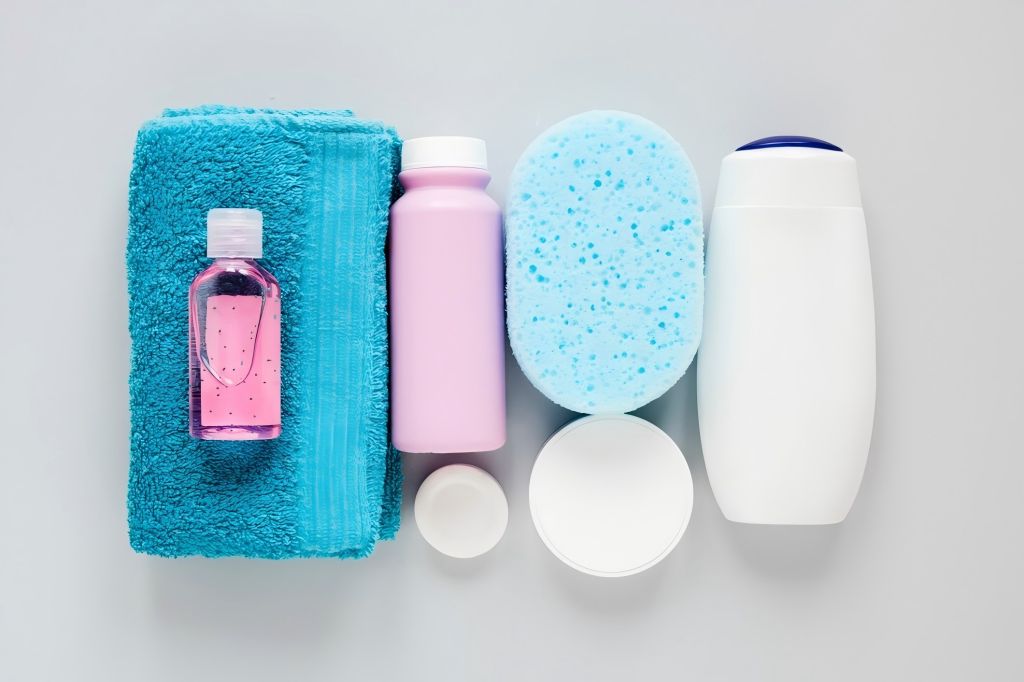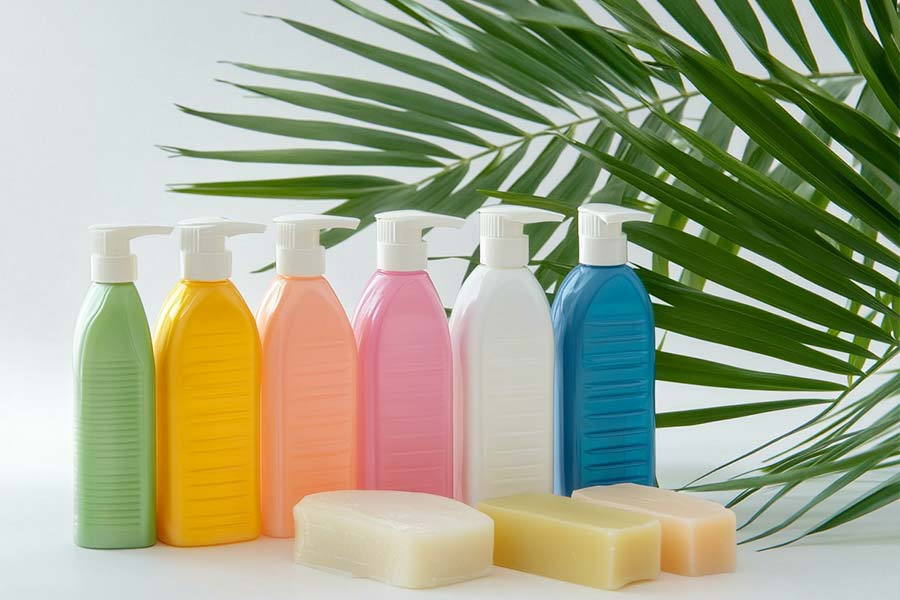A popular synthetic surfactant, sodium lauryl ether sulfate (SLES) is well-known for its superior detergent qualities and capacity to produce foam. SLES, which comes from ethoxylated lauryl alcohol, is frequently found in home cleaning goods and personal care items like shampoos and body washes.
It is preferred for its effectiveness in removing oils and stains, its ability to create a rich lather, and its relatively mild impact on the skin compared to similar substances. This introduction provides a brief overview of SLES’s role and benefits in various consumer products.

Production Process of Sodium Lauryl Ether Sulfate
The manufacturing of Sodium Lauryl Ether Sulfate involves several key steps, starting from basic raw materials to the final product. Here is a concise overview of the process:
1. Raw Material Preparation
- Lauryl Alcohol: Produced from petrochemicals or from natural fats and oils.
- Ethylene Oxide: A reactive compound used to ethoxylate lauryl alcohol.
2. Ethoxylation
- Reaction Process: Lauryl alcohol is reacted with ethylene oxide in a reactor under controlled conditions of temperature and pressure. The number of ethylene oxide groups added varies depending on the desired properties of the SLES, such as the degree of foaming and mildness.
- Product: The outcome is lauryl ether, an ethoxylated form of lauryl alcohol.
3. Sulfation
- Sulfating Agent: The ethoxylated alcohol is treated with sulfur trioxide to produce the sulfated product.
- Controlled Conditions: To guarantee full conversion, this reaction is usually conducted continuously at regulated temperatures.
4. Neutralization
- Sodium Hydroxide: The acidic form of the sulfated ethoxylated alcohol is neutralized with sodium hydroxide (NaOH) to form the sodium salt, which is the usable form of SLES.
- Purification and Quality Control: Any unreacted components and byproducts are eliminated from the finished product through purification. Quality control tests are performed to ensure the product meets specific performance and safety standards.
5. Packaging and Distribution
- Final Form: SLES is typically sold as a viscous liquid or paste and is packaged for distribution to various cosmetic and cleaning product manufacturers.
- Logistics: To preserve the product’s integrity while in transit, careful handling and storage are required.
The production process of SLES is designed to achieve a balance between efficiency and safety, ensuring that the product delivered to the market meets rigorous quality standards while also being economically feasible to produce..

Key Applications of Sodium Lauryl Ether Sulfate
Sodium Lauryl Ether Sulfate (SLES) is a versatile surfactant that finds applications across a broad range of industries due to its effective cleaning properties and ability to generate a rich lather.
Here are some of the key areas where SLES is extensively used:
1. Personal Care Products
- Shampoos and Conditioners: SLES is a primary ingredient in many hair care products due to its ability to remove oils and dirt while providing a creamy foam that enhances the user experience.
- Body Washes and Soaps: It is used in shower gels and body washes for its excellent foaming and emulsifying properties, which help in cleansing the skin effectively without excessive drying.
- Toothpaste: SLES helps in distributing the toothpaste evenly over the teeth and creates foam, which aids in the removal of debris and plaque.
2. Household Cleaning Agents
- Laundry Detergents: In laundry applications, SLES helps to emulsify and remove oils and grease from fabrics, making them cleaner.
- Dishwashing liquids: They effectively remove food residue and oil from dishes, making cleaning them simpler.
- All-Purpose Cleaners: SLES is used in multipurpose cleaning products for its ability to dissolve dirt and build-up on various surfaces.
3. Industrial Applications
- Industrial Cleaners: Due to its strong degreasing properties, SLES is utilized in cleaners used in the automotive, manufacturing, and maintenance sectors.
- Agrochemicals: It serves as a wetting agent in pesticide and herbicide formulations, helping to spread the chemical uniformly over the plant surfaces.
4. Cosmetic Products
- Creams and Lotions: SLES helps to stabilize emulsions in cosmetic formulations, ensuring that the oil and water components do not separate, and enhances the spreadability of creams and lotions on the skin.
The widespread use of SLES in these applications is due to its effectiveness as a surfactant, its relative mildness compared to other detergents, and its cost-efficiency, making it a popular choice among manufacturers of various consumer products.
Environmental and Health Impact
Sodium Lauryl Ether Sulfate (SLES) is a commonly used surfactant in many household and personal care products, and while it offers numerous benefits, it also poses certain environmental and health challenges. Here’s an overview:
Environmental Impact
- Biodegradability:
- Positive: SLES is generally considered to be biodegradable under aerobic conditions, breaking down in sewage treatment facilities.
- Concerns: Incomplete degradation can occur, leading to residues that might affect aquatic ecosystems.
- Waterborne Toxicology:
- Impact: In greater quantities, SLES can be harmful to aquatic life. It can affect fish and other marine organisms, disrupting their reproductive and growth patterns.
- Mitigation: Treatment plants and proper formulation can reduce the levels of SLES discharged into water bodies.
Health Impact
- Skin and Eye Irritation:
- Symptoms: Direct contact with SLES can cause skin and eye irritation in some individuals, manifesting as redness, itching, or dermatitis.
- Precaution: Using products as directed and avoiding prolonged exposure can minimize risks.
- Long-term Exposure:
- Studies: There have been concerns about the long-term exposure effects of SLES, particularly related to its potential as a carcinogen. However, current research does not conclusively link the normal use of SLES-containing products to cancer.
- Regulation: Regulatory bodies continue to monitor and evaluate scientific data to ensure safety standards are met.
Regulatory and Safety Standards
- Safety Guidelines: Regulatory agencies such as the U.S. Food and Drug Administration (FDA) and the European Chemicals Agency (ECHA) monitor SLES to ensure its safety in consumer products.
- Labeling Requirements: Products containing SLES require clear labeling to inform consumers of their presence, allowing for informed choices.
Mitigation Strategies
- Product Reformulation: Manufacturers are increasingly exploring formulations that reduce the concentration of SLES, or substitute it with milder alternatives to lessen environmental and health impacts.
- Consumer education: Giving customers clear safety information and usage guidelines encourages them to use SLES-containing goods in a more responsible and safe manner.
Understanding the environmental and health impacts of SLES is crucial for consumers and manufacturers alike, promoting safer use and encouraging the development of more sustainable and health-conscious products.
Market Dynamics of Sodium Lauryl Ether Sulfate
The market for Sodium Lauryl Ether Sulfate (SLES) is influenced by several factors ranging from industrial demand to environmental regulations. Below is a summary of the key elements impacting the SLES market:
Aspects of Demand
1. Growth in Personal Care and Cleaning Industries
Primary Driver: The expanding global market for personal care products and household cleaners significantly boosts the demand for SLES, as it is a key ingredient in many such formulations.
Regional Trends: Emerging markets in Asia, Latin America, and Africa are seeing rapid growth in these sectors, further fueling demand.
2. Consumer Preferences
Shift to Mild Surfactants: While SLES is less irritating than its cousin Sodium Lauryl Sulfate (SLS), there is a growing consumer preference for even milder and more environmentally friendly surfactants, which influences market dynamics.
Supply Factors
1. Raw Material Availability
Impact on Production: The availability and price of key raw materials like lauryl alcohol and ethylene oxide directly affect SLES production costs and supply stability.
2. Manufacturing Capabilities
Technological Advances: Innovations in production technologies can lead to more efficient processes, reducing costs and environmental impact, and potentially increasing supply.
Economic and Regulatory Factors
1. Economic Conditions
Market Sensitivity: The SLES market is sensitive to overall economic conditions that affect manufacturing and consumer spending patterns.
2. Environmental Regulations
Compliance Costs: Stricter environmental regulations can increase production costs or push for reformulations that might reduce the use of SLES in some applications.
Market Patterns and Prospects
1. New Developments in Product Formulation
Alternative Surfactants: Ongoing research and development are likely to introduce new surfactants that could compete with or complement SLES in various applications.
2. Sustainability Initiatives
Eco-friendly Products: There is an increasing trend towards sustainable and environmentally friendly products, which may affect the demand for traditional surfactants like SLES.
3. Market Forecasts
Steady Growth: Despite challenges, the global demand for SLES is expected to grow modestly, driven by its extensive use in essential cleaning and personal care products.
Understanding these dynamics is crucial for stakeholders in the SLES market to navigate the complexities and capitalize on opportunities within this essential industrial commodity.
Conclusion
Because of its efficient cleaning and foaming qualities, sodium lauryl ether sulfate (SLES) is still a necessary ingredient in personal care and cleaning products. As the market for SLES grows, particularly in emerging regions, the industry faces increasing pressure to address environmental and health concerns. Innovations and regulations are steering the market towards more sustainable and safer products, influencing both the demand and supply dynamics of SLES.
Despite challenges, SLES is likely to remain a key surfactant in the global market, supported by ongoing developments that aim to balance its widespread use with environmental stewardship and safety considerations. As consumer preferences evolve, the industry’s response will be crucial in shaping the future of SLES in a more eco-conscious world.

